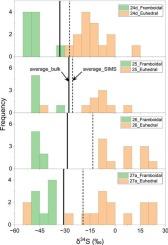The representativeness of in-situ sulfur isotopic results for sedimentary pyrite: Implications for tracing ore-forming fluids
IF 3.6
2区 地球科学
Q1 GEOLOGY
引用次数: 0
Abstract
The sulfur isotopic composition of sedimentary pyrite is frequently measured and compared with that of ore stage sulfides to assess the contribution of sulfur from sedimentary pyrite. In-situ analysis methods, notably secondary ion mass spectrometry (SIMS) and laser ablation multi-collector inductively coupled plasma mass spectrometry (LA-MC-ICP-MS), are both efficient and convenient for determining the sulfur isotopic composition of sedimentary pyrite and have been widely used in recent studies.
However, the representativeness of in-situ analysis results has rarely been investigated. In this study, we investigate this topic by analyzing sedimentary pyrite using SIMS. The samples were collected from the Meishan section in South China. The results show that framboidal and euhedral pyrite tend to have low and elevated δ34S values, respectively. The average δ34S value obtained by SIMS analysis is generally higher (up to ∼15 ‰) than that derived using bulk analysis in which pyrite was extracted using chromium reduction method. Since LA-MC-ICP-MS employs a larger spot size (25–50 μm), and only euhedral pyrite typically has a relatively large diameter, LA-MC-ICP-MS analysis would like yield even higher δ34S values than SIMS. This suggests that in-situ sulfur isotopic results may not be fully representative of the sulfur isotopic composition of sedimentary pyrite.
A compilation of reported in-situ sulfur isotopic compositions of pyrite in the sedimentary host rocks in the “Golden Triangle” area shows that the average δ34S value (∼+9‰) is significantly higher than those obtained through bulk analysis from South China and globally (<−10 ‰), which is consistent with observation at Meishan.
Consequently, we suggest that combining bulk analysis, in which all the sulfur was extracted, with in-situ method, which provides sulfur isotopic compositions with detailed textural and temporal contexts, offers the most robust interpretation when tracing the source of sulfur in the ore-forming fluids.

沉积黄铁矿原位硫同位素结果的代表性:示踪成矿流体的意义
沉积黄铁矿的硫同位素组成经常被测量,并与矿期硫化物的硫同位素组成进行比较,以评估沉积黄铁矿硫的贡献。原位分析方法,特别是二次离子质谱法(SIMS)和激光烧蚀多集电极电感耦合等离子体质谱法(LA-MC-ICP-MS)是测定沉积黄铁矿硫同位素组成的高效、简便的方法,在近年来的研究中得到了广泛的应用。然而,对原位分析结果的代表性研究却很少。本研究利用SIMS对沉积黄铁矿进行了分析。样品采集于中国南方梅山剖面。结果表明:草莓状黄铁矿δ34S值较低,自形黄铁矿δ34S值较高;SIMS分析得到的平均δ34S值通常比用铬还原法提取黄铁矿的体分析得到的δ34S值高(可达~ 15‰)。由于LA-MC-ICP-MS采用更大的光斑尺寸(25-50 μm),并且只有自形黄铁矿通常具有相对较大的直径,因此LA-MC-ICP-MS分析的δ34S值可能比SIMS更高。这表明,原位硫同位素结果可能不能完全代表沉积黄铁矿的硫同位素组成。对“金三角”地区沉积寄主岩中黄铁矿的原位硫同位素组成进行了整理,结果表明,黄铁矿的平均δ34S值(~ +9‰)明显高于华南地区和全球块状分析所得的平均值(<−10‰),与眉山观测结果一致。因此,我们建议,在追踪成矿流体中硫的来源时,将整体分析(其中提取了所有的硫)与现场方法(提供了详细的结构和时间背景的硫同位素组成)相结合,可以提供最可靠的解释。
本文章由计算机程序翻译,如有差异,请以英文原文为准。
求助全文
约1分钟内获得全文
求助全文
来源期刊

Ore Geology Reviews
地学-地质学
CiteScore
6.50
自引率
27.30%
发文量
546
审稿时长
22.9 weeks
期刊介绍:
Ore Geology Reviews aims to familiarize all earth scientists with recent advances in a number of interconnected disciplines related to the study of, and search for, ore deposits. The reviews range from brief to longer contributions, but the journal preferentially publishes manuscripts that fill the niche between the commonly shorter journal articles and the comprehensive book coverages, and thus has a special appeal to many authors and readers.
 求助内容:
求助内容: 应助结果提醒方式:
应助结果提醒方式:


